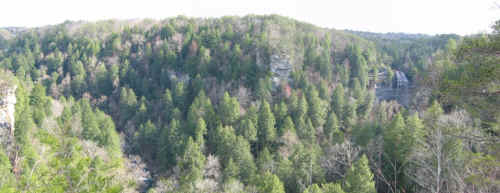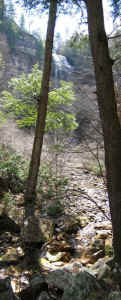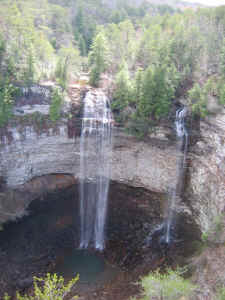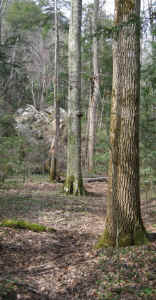Ents,

Falls panorama from overlook - photo by Will Blozan
Fall Creek Falls State Resort Park encompasses over 20,000 acres
on
the western edge of Tennessee's Cumberland Plateau. On the
park's
flat plateau lands, the state has developed several amenities;
cabins,
picnic areas, a lake, and a golf course; to accommodate
travelers from
Knoxville, Chattanooga, and Nashville, all about equidistant,
but the
central attraction of the park remains the waterfalls. Cane
Creek,
Falls Creek, and Piney Creek plunge over the thick, erosion
resistant
layer of sandstone that forms the top of the plateau into two
gorges
that reach a depth of 600 feet. Cane Creek has the largest water
volume, but the park's namesake fall has achieved the greatest
notoriety for a 180' free drop. The waterfalls, gorges, and much
of
the undeveloped plateau lands now make up a state natural area.

Falls from below - photo by Will Blozan |

Falls as viewed from overlook and plunge pool - photo by
Will Blozan
|
Not surprisingly, steep slopes and copious boulders limited
logging in
the gorges. Previous estimates of old growth in the park range
from
20 to 200 acres and suggest extensive selective cutting (Davis
2003).
While loggers could have removed the largest tuliptrees and a
few
other valuable individuals, old trees occupy much of the Cane
Creek
gorge, and the upper reaches of the gorge are likely untouched.
Sandstone underlies that section of the gorge, so hemlock
strongly
dominates the canopy. Farther down the gorge, layers of
limestone
allow a diverse, mixed mesophytic forest to develop on the north
and
east facing slopes. The rich forest generally resembles the
forests
of Savage Gulf, but pignut hickory, cucumbertree, and basswood
are
less common. Basswood still makes up a significant portion of
the
overstory mixed with sugar maple, hemlock, yellow buckeye, and
smaller
quantities of several other hardwoods. Under them grow yellow
birch
and a thin understory of striped maple. In early spring,
acute-leaved
hepatica, spring beauty, purple phacelia, and intermediate wood
fern
grew on the boulders and forest floor.

Large eastern hemlock - photo by Will Blozan
|

Jess Riddle measuring large shagbark hickory in boulder field
- photo by Will Blozan
|
More surprisingly, uncut forests remain atop the plateau;
however,
these forests bear scant resemblance to the towering cove
forests in
the gorges below. Amongst a patchwork of developed areas,
clearcuts
of the last few decades, and mature second growth, several
tracts,
probably totaling hundreds of acres, of stunted oak forests
survive on
the gentle terrain of the plateau. Crinkly white, post, and
scarlet
oaks form a low canopy with scattered black oaks and southern
red oaks
and patches of virginia pine. The dry forests boast an open
understory except near the edges of the gorges where mountain
laurel
and chestnut oak are common. Unfortunately, significant sections
of
this forest may have been lost to development and cutting over
the
past few decades.
Species Cbh Height
Ash, Green 8'0" 143.9'
Ash, Green 6'11" 146.7'
Basswood, White 7'9.5" 127.3'
Basswood, White 6'3" 135.1'
Basswood, White 6'3.5" 136.0'
Basswood, White 6'3" 153.2'
Beech, American 8'0" 127.3'
Beech, American 10'3" 127.6'
Beech, American 8'4" 131.7'
Beech, American 10'2" 136.3'
Buckeye, Yellow 7'7" 124.7'
Buckeye, Yellow 9'1" 139.4'
Elm, American 10'1" 96.0'
Elm, American 9'2" 111.7'
Hemlock, Eastern 11'4" 147.6'
Hickory, Bitternut 7'11" 134.1'
Hickory, Bitternut 6'0" 137.4'
Hickory, Shagbark 6'8" 146.1'
Hickory, Shagbark 7'8" 147.7'
Maple, Sugar 8'3" 127.1'
Sycamore 7'7" 132.9'
Tuliptree 8'7" 159.7'
Rucker Height Index 142.8'
Tuliptree 159.7'
White Basswood 153.2'
Shagbark Hickory 147.7'
Eastern Hemlock 147.6'
Green Ash 146.7'
Yellow Buckeye 139.4'
Bitternut Hickory 137.4'
American Beech 136.3'
Sycamore 132.9'
Sugar Maple 127.1'
The 146.7' green ash is the second tallest known, and tallest in
Tennessee.
The basswood slightly eclipses one at Savage Gulf for the
eastern
height record although Savage Gulf still has more tall
basswoods.

Tall Green Ashes -photo by Will Blozan |

Beech and Ash Forest - photo by Will Blozan |
The beeches may constitute one of the tallest known groves in
the
southeast, and the 136.3' individual is the second tallest ENTS
has
identified. No other site in the southeast is known to have
multiple
beech over 130', but that fact may change with additional
searching at
Meeman-Shelby State Park.
The Rucker Index is the third highest in Tennessee behind the
Smokies
and Savage Gulf, which rank one and two in the eastern U.S.
respectively.
Jess Riddle & Will Blozan
Davis, Mary Byrd. Old-Growth in the East: A Survey. Rev. Ed.
Appalachia-Science in the Public Interest. 2003.
|